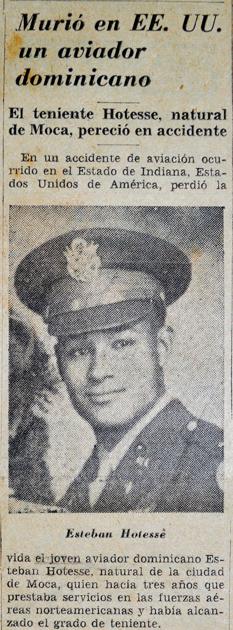Tuskegee Airman Esteban Hotesse was born on February 11, 1919 in Moca, Dominican Republic. Little did his family know that he would go down in United States history as an admired pilot and civil rights activist. Actually, no one knew. Until recently.
“In 2015 the City University of New York's American Studies Institute discovered that oh this was the only Dominican board member of the Tuskegee Airmen," Dominican Actress, and In the Heights star, Dascha Polanco explains in a YouTube video about his life. "Before that the story of Estevan Hotesse was largely unknown. But this Tuskegee Airmen made American history. And he was Afro Latino."
Who was this unsung hero?
From Moca to Tuskegee
When he was just four, Hotesse immigrated to the United States from the Dominican Republic with his family.
“After traveling through Ellis Island, they took up residence in Manhattan,” the nonprofit site BlackPast.org reports. “Little is known of Hotesse from this point until he enlisted in the United States Army Air Corps on February, 21, 1942."
This is when Hotesse’s life took a decisive turn. He entered the Tuskegee Flight School Program, a beacon of hope for African American aviators, who eventually changed the way race was viewed in the U.S. military, and beyond.
Hotesse earned his commission as a second lieutenant and donned the coveted flight wings. His path was set — he was a Tuskegee Airman.
Wings of Valor: Esteban Hotesse
The Tuskegee Airmen stood tall against prejudice and adversity. They were the first African American military pilots in the United States Army Air Forces (USAAF).
“Trained at the Tuskegee Army Air Field in Alabama, they flew more than 15,000 individual sorties in Europe and North Africa during World War II,” the History channel explains. “Their impressive performance earned them more than 150 Distinguished Flying Crosses, and helped encourage the eventual integration of the U.S. armed forces.”
Hotesse’s journey unfolded stateside. He never tasted combat abroad, but his commitment burned bright. Assigned to the 477th Bombardment Group, he trained with dedication. His B-25 Mitchell bomber awaited its moment.
“In March of 1945, the group was transferred to Freeman Army Airfield, near Seymour, Indiana. Although they never saw battle during the war, here they became famous for their involvement in the civil rights struggle through the instigation of the event now known as the Freeman Field mutiny,” BlackPast.org writes.
The Freeman Field Mutiny
On April 5, 1945, Colonel Robert Selway, a racial segregationist, divided the officer’s club by race. Black officers, including Hotesse, challenged this injustice. Peacefully, they entered the whites-only club, demanding equality. Arrests followed.
“ was among a group of 101 Tuskegee Airmen officers arrested for refusing to follow Jim Crow orders from a white commanding officer at a base near Seymour, Indiana, where the KKK had a strong presence. This act of disobedience later became known as the 'Freeman Field Mutiny'," Edward De Jesus, a research associate at the Dominican Studies Institute at CUNY, explains.
Hotesse’s courage echoed through the corridors of Freeman Field. He stood alongside his fellow airmen, defying prejudice. Their actions shook the foundations of discrimination.
Remembering Esteban Hotesse
In July 1945, Hotesse died in a plane crash. “He was only twenty-six at the time, and left behind a wife and two young daughters, who today reside in New York City,” IQLatino writes.
Today, he is remembered as the only Dominican-born Tuskegee Airman, who fought peacefully to bridge cultures and continents, and to end racism in America. 
In 2018, City College of New York’s CUNY Dominican Studies Institute, and U.S. Representative Adriano Espaillat, held a ceremony to award Hotesse with the U.S. Congressional Gold Medal, in a ceremony in New York. The medal that was issued to other Tuskegee Airmen was presented to his family.





